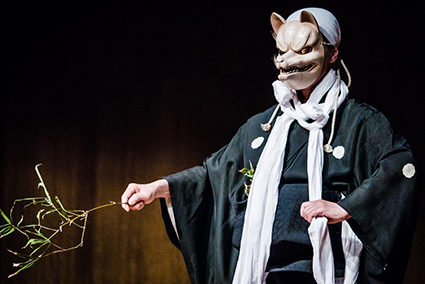The perils of emptiness overcome
Felicity Clark: Theatre Nohgaku, Oppenheimer

Yoke Chin as fox-dancer, Oppenheimer
photo Lee Nutter
Yoke Chin as fox-dancer, Oppenheimer
Cursed to live 500 lives as a fox for wrongly concluding that an enlightened being falls outside the laws of karma (cause and effect), the weary spirit of a monk, Hyakujo, has become legend. A waki (traveller) goes to Hiroshima to find a temple associated with foxes, where this ancient priest’s wisdom might ease his aching heart. There he encounters Hyakujo who later reveals his true identity as the ghost of Robert Oppenheimer (whose spirit is a shape-shifter), cursed to a cycle of suffering for his contribution to the making of the atomic bomb. The action unfolds, typically slowly, with every opportunity for allegory taken.
Part of the story is told from the viewpoint of siblings who have come to the fox temple to honour the grave of their father, killed in Hiroshima in 1945. The daughter performs a fox dance while her brother and the traveller look on. In Japanese mysticism foxes are shape-shifters and fox-symbolism often indicates messages from the afterlife. There are two kinds of spirit foxes though, Inari (the good rice-prosperity deity) and Yakkan (evil mischief-maker), and perhaps for this reason foxes signify schizophrenia in some Japanese art. Hot tip for budding Noh fans: when the fox-dancer bears a branch it implies she is herself; when not it suggests she is possessed by the fox spirit.
When the siblings depart, Oppenheimer’s ghost re-appears in fantastic gilded kimono and long black wig and is confronted by the Buddhist wisdom king Fudô Myô-ô in even shinier robes and a bright red wig. He sets Oppenheimer free from his anguish once Oppenheimer voluntarily immolates himself by entering the fires of Hiroshima. Fudô Myô-ô is usually depicted seated resolute in flames, carrying a sword and snare to liberate people from impediments to enlightenment. He appears fierce but is a force of positive change, like Kali in Hindu mythology. The play alludes to the burning pain suffered by the people of Hiroshima and Oppenheimer trusts that his immolation will relieve the torture inflicted by his (but not his alone) careless application of scientific expertise.
The creator of Oppenheimer, Allan Marett, built layer upon layer of metaphor into the plot, each scene looking at equivalent situations from different angles. This approach mirrors a Zen method of enquiry. One of his inspirations was a collection of Zen koans, the Mumonkan (‘a gateless barrier’), which contains the story of Hyakujo and his fox lives. Marett mused over this story and created a drama where the protagonist seeks deliverance from torment born of his impeded perspectives. Oppenheimer is dazzled by that Zen emptiness which is limitless, formless and has no inverse: Like Hyakujo he misunderstood its relationship to the material world. Oppenheimer misused a scientific discovery so destructive it consumed him too. With taut, well-woven themes, pregnant with signification like so much stylised Japanese-inspired art, Oppenheimer reveals a mastery of form that is also social commentary.
When it comes to stylisation, it’s as much about what’s not there as is there. The torpid sparseness of Noh makes the costumes seem more elaborate, the text more parabolic, the music sweeter and the dance more ecstatic. It heightens every particular. In the performance I saw, within the Noh orchestra always visible on stage, I thought I detected a combative dynamic playing out between the o-tsutsumi and ko-tsutsumi drummers which drew my attention because Noh’s form affords space for reflection. Their exchange reconfigured the energy of Oppenheimer, reinforcing the emotional journey of all the troubled souls that met in the story.
All the performances were excellent, especially the chorus made up of local performers along with David Crandall as the waki; those in masks (made by Hideta Kitazawa): John Oglevee as Oppenheimer; Akira Matsui as Fudô; and Yoke Chin as fox-dancer.
Marett, Emeritus Professor of Musicology at Sydney University, a Noh specialist and the librettist for Oppenheimer, went to Japan 40 years ago to understand Noh. His collaborator on this work, Noh performer and instructor Richard Emmert, formed Theatre Nohgaku in Tokyo so he and friends could produce Noh plays in English primarily for English-speaking audiences, as a way to generate further interest in the form.
Sung through elaborate masks in a low grumbly warble, characteristic of shomyo (ancient Japanese Buddhist monody), the text remained unclear, despite the performers’ excellent diction and vocal production. Surtitles helped, especially in catching quotations and references, for example to the Faust story.
The waki is a fictional character inspired by Marett’s personal experience: in 2013 Marett was drawn to Hiroshima while walking the 1200km coast of Shikoku as a Henro pilgrim. Approaching Hiroshima, he and wife Linda realised they were ‘following the path’ of the bomb-carrying Enola Gay, adding heaviness to their grieving steps. Together they chanted, through tears, the Emmei Jikku Kannon-gyo, an invocation of compassion that concludes, “Thought is not separate from mind.” Deeply knowledgeable creative minds invested in living and preserving Japanese art forms here—Emmert (music), Marett (text) and Matsui (director)—have produced in Oppenheimer a truly moving work.
You can see the full production here.
Oppenheimer, A Noh Play in English, text Allan Marett, music Richard Emmert, choreography, direction Akira Matsui, masks Hideta Kitazawa; Sydney Conservatorium of Music, 30 Sept-1 Oct, www.theatrenohgaku.org
RealTime issue #130 Dec-Jan 2015 pg. 41






